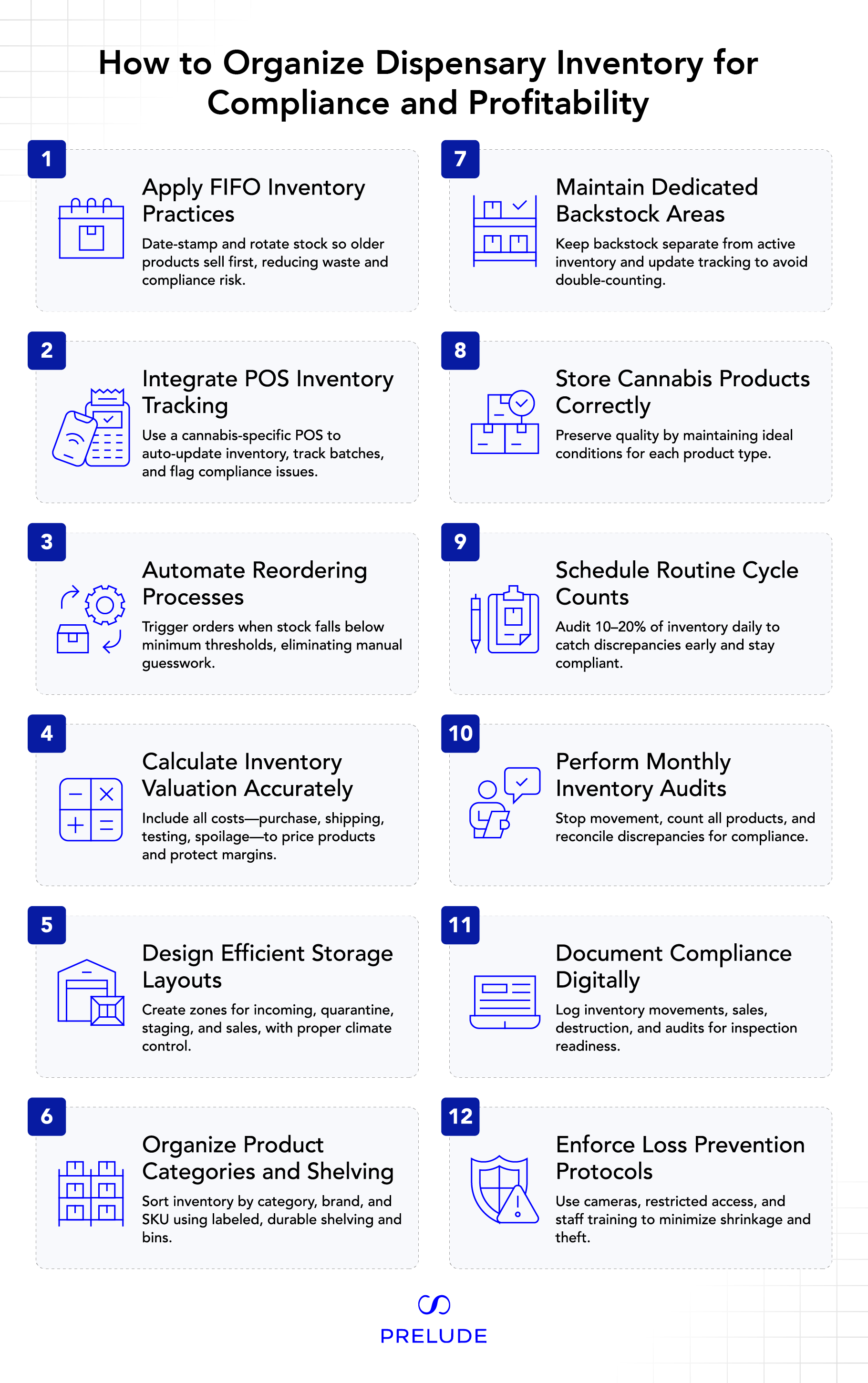One mislabeled jar. One missing batch. One expired product that somehow made it into a sale. That’s all it takes to throw you into a storm of compliance issues, customer complaints, and lost revenue. Learning how to organize dispensary inventory isn’t just a back-office chore, it’s a frontline defense for your license and your bottom line.
Running a dispensary inventory is not just about tracking what’s in stock. It means staying compliant, predicting demand, avoiding waste, and protecting your margins, all at once. And without a clear system, things slip fast. A First-In, First-Out (FIFO) system, combined with integrated POS software and routine audits, can turn inventory from a weak spot into one of your strongest assets. It reduces risk, improves accuracy, and keeps operations steady, without adding more work. These simple, repeatable practices are built specifically for dispensary owners and managers who want better inventory control, fewer mistakes, and a setup that supports growth. If you're wondering how to organize dispensary inventory while staying compliant and profitable, this guide is for you.
Key Takeaways
- Using FIFO and a cannabis-specific POS lays the groundwork for better compliance and product tracking.
- Regular audits and thoughtful storage design help avoid fines, product loss, and operational breakdowns.
- Automated inventory systems free up time, protect your license, and improve your bottom line.

Foundational Inventory Management Systems
Every well-run dispensary relies on strong inventory systems that keep products flowing, records clean, and compliance tight, all while making it easier to hit your sales targets. With constant staff changes and pressure to move product fast, a reliable system isn’t a luxury, it’s how you stay open and master how to organize dispensary inventory effectively.
FIFO (First-In-First-Out) Methodology
Outdated products sitting in storage are not just a waste. They are a liability. And when inspectors show up or customers complain about stale inventory, the fallout lands squarely on you. FIFO fixes that, but only if done right. When older stock doesn’t move first, you risk expired products sitting on your shelves, which is a major liability.
We suggest setting up storage zones clearly labeled with both arrival and expiration dates. Use color-coded stickers or tags so staff can rotate stock without guesswork. It’s a small upfront effort that pays off fast. Think fewer compliance issues, less shrinkage, and smoother audits.
Practical FIFO Implementation:
- Stamp every item with a received date.
- Set shelving so staff loads new products behind existing inventory.
- Train staff to visually check labels before pulling products.
- Log movement through your POS or tracking system to close the loop.
By implementing these dispensary inventory control methods, you’re creating a system that scales with your business.
POS Integration for Automated Inventory Tracking
A cannabis-specific POS does more than handle sales. It’s your second set of eyes on inventory. When integrated with your tracking system, it updates inventory automatically and flags potential issues before they become costly.
Think of it as your built-in safety net. When people make mistakes, and they will, the system helps you catch them before they spiral into lost product or compliance violations.
Your system should handle:
- Auto-adjusting stock levels after every sale
- Batch-level tracking and recall readiness
- Scheduled compliance reports
- Low-inventory alerts
Look for barcode scanning to speed up intake and reduce entry errors. That one simple feature shaves off hours of manual work weekly and drastically cuts human error. Inventory optimization software also helps reduce waste and supports automated reporting, making it easier to organize dispensary inventory with confidence.
Implementing Automated Reordering Technology
Managing inventory is a balancing act—too much ties up capital, too little risks lost sales. Automated reordering systems solve this by continuously monitoring inventory levels and sales trends, then triggering restock orders as soon as stock drops below predefined thresholds. This eliminates manual guesswork and ensures your shelves stay stocked without overstocking.
With automated reordering:
- Inventory optimization software tracks sales updates and current stock.
- When inventory falls below a set minimum, the system automatically generates purchase orders.
- The system can factor in daily sales trends, seasonal swings, and promotions, adjusting reorder points dynamically.
- Managers receive alerts or approvals as needed, keeping workflows efficient and responsive.
Regularly review and update system parameters as new products gain traction or demand shifts, ensuring your inventory remains lean, responsive, and optimized for sales. The right inventory optimization software also helps you respond to demand changes faster, preventing both overstock and out-of-stocks that eat into margins.

Inventory Valuation Methods for Cannabis Products
Knowing how to organize dispensary inventory includes tracking valuation factors like shipping, testing, and spoilage, especially when applying it across different cannabis formats. Accurate valuation isn’t just about accounting. It affects taxes, profitability tracking, and how you price products. Misjudge it, and you’re either overpaying taxes or undercutting your own margins. That adds up fast, especially with tight markups and unpredictable demand.
Make sure you factor in:
- Purchase cost
- Shipping and receiving fees
- Lab testing charges
- Storage conditions
- Expected spoilage
Different product types (e.g., flower vs. edibles) need their own valuation logic. For example, concentrates may involve higher testing fees, while edibles require tighter temperature control. Cutting corners here leads to messy audits and pricing mismatches down the line.
Track every change in pricing to make smarter purchasing decisions in the future. Over time, this lets you spot patterns, avoid overpaying, and hold vendors accountable.
Physical Organization Strategies
The way you organize your physical space matters just as much as your tracking system. A smart layout makes staff faster, audits easier, and product handling safer.
Optimizing Dispensary Storage Room Layout
Your storage layout should be built for speed and compliance. That means keeping things accessible while also meeting health and safety rules. When your storage room is a maze, mistakes pile up fast, especially with new staff or surprise inspections.
Designate separate zones for:
- Incoming inventory (unprocessed)
- Quarantine (damaged, expired, or pending review)
- Staging (ready to be shelved or sold)
Maintain stable temps (75-80°F) and humidity (65-70%) to preserve product quality. This will save you from product degradation that silently eats into profits. Bright lighting and a clear one-way flow help reduce confusion, especially when multiple team members are working at once.
Keep best-sellers closer to the front to reduce wasted steps.
Product Categorization and Shelving Systems
Sorting products into clearly labeled categories helps staff find what they need fast and avoid mix-ups during busy times.
Use the following categories as your base:
- Flower
- Concentrates
- Edibles
- Topicals
- Accessories
Install durable, easy-to-clean shelving with adjustable heights. Don’t skimp here because weak shelves and poor layout slow your team down and invite accidents. Tailor your shelving, labeling, and stock zones with dispensary inventory control methods that keep staff efficient and audits clean.
Within categories, organize alphabetically by brand or strain, and clearly display SKU numbers. For smaller products, bins make better use of vertical space.
Backstock Management Techniques
Backstock should never get mixed in with active inventory. It needs its own space, its own labeling, and its own checks.
Here’s what works:
- Separate overflow zones labeled by category
- FIFO applied to backstock just like active inventory
- Visible reorder points (on bins or digital dashboards)
- Consistent updates to your tracking system to prevent double-counting
This may take a bit of discipline but it pays off during audits and eliminates stock mysteries that waste your time.
Storage Solutions for Different Cannabis Products
Store everything the same way, and you’re guaranteed to ruin something. Each cannabis format has its quirks, and ignoring them cuts shelf life, quality, and compliance.
- For flower: airtight, dark containers with humidity control packs
- For concentrates: coolers set to 50–60°F, with limited light exposure
- For edibles: food-grade containers kept away from other products
- For topicals: shelves in dry, cool conditions out of direct sun
Security also matters. Use visible cameras and restrict access to inventory areas. It’s not just about theft. It’s about traceability and protecting yourself during investigations.
A clean storage room is a safe storage room. When inspectors walk in, it speaks volumes before you even say a word.
Inventory Audit and Compliance Protocols
Your inventory audit system isn’t just for catching mistakes. It’s your first line of defense in staying licensed and avoiding costly penalties. One missed entry or unlogged transfer can trigger a red flag that puts your entire operation at risk. It’s all about survival in a tightly regulated industry.
Regular Cycle Counting Procedures
Organizing your dispensary inventory is also about preparation. You don’t want to find out about inventory issues when the inspector’s already on-site. Daily cycle counts let you catch small problems before they spiral into compliance violations or customer-facing errors.
We recommend auditing 10–20% of your inventory each day.
Build a rotating schedule focused on high-volume and high-value products first. That’s where errors and losses hurt the most. Prioritize them. Early morning counts usually go smoother when everyone’s sharp and traffic is low.
Set acceptable variance thresholds and flag anything beyond them for review. Record every discrepancy in both your POS and METRC to stay synced.
Comprehensive Inventory Audits
Cycle counts are great but they won’t catch everything. A full inventory audit gives you a reset point before mistakes stack up and margins quietly erode.
Schedule full-store audits every month. These audits reset your baseline and catch trends over time.
Your process should look like this:
- Stop all inventory movement before starting.
- Print inventory reports from METRC and your POS.
- Count every product manually, by category.
- Investigate any discrepancies and assign accountability.
- Report findings to your compliance officer.
- Store records for at least three years.
Two-person teams make this process more accurate and less vulnerable to mistakes or manipulation. And when team members know they’re being double-checked, accuracy improves across the board.
Compliance Documentation Systems
Clean, digital documentation means you're inspection-ready every single day. Each product interaction needs a record tied to a specific employee and date.
You’ll need logs for:
- Daily sales recaps
- Product destruction (with verified witness)
- Incoming/outgoing transfers
- Cycle counts and audits
- Employee training events
These records are your receipts when regulators come asking. Having them ready before a surprise inspection can mean the difference between a warning and a shutdown.
Loss Prevention Strategies
Inventory shrink is a silent threat to your margins and your license. And it often starts with small, preventable errors. Losses can come from many places. In the cannabis industry, about 90% of loss, both product and financial, comes from the inside.
Cameras, access restrictions, and training all help reduce exposure.
Keep an eye on:
- Patterns of missing products
- Incorrect weights or package damage
- Human error at check-in or checkout
- Potential internal or customer theft
Educate staff on weighing protocols and batch verification. Random checks during shifts reinforce expectations and protect against complacency.
When Inventory Is in Order, Everything Runs Smoother
In the cannabis retail world, chaos doesn't start with disaster. It starts with a few small oversights. A miscount here. An unlabeled bin there. Suddenly you’re chasing problems instead of running your business. But knowing how to organize dispensary inventory changes that. With FIFO as your foundation, a purpose-built POS, clear storage zones, and a consistent audit routine, inventory becomes less of a risk and more of a competitive edge. These systems don’t just keep you compliant. They free up time, cut stress, and give your team the clarity they need to operate with confidence.
If you’re ready to stop putting out fires and start running a tighter ship, Prelude can help you build the inventory system your dispensary actually needs. By implementing proven dispensary inventory control methods, you set your business up for smoother audits, stronger compliance, and long-term success. Check out Prelude in action to see how smart dispensary inventory starts and scales.



